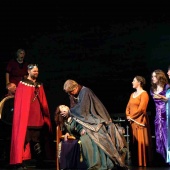Tristan und Isolde

| Hugh Keelan | |||||
| TUNDI Festival Chorus and Orchestra | ||||||
Date/Location
Recording Type
|
| Tristan | Alan Schneider |
| Isolde | Jenna Rae |
| Brangäne | Roseanne Ackerley |
| Kurwenal | Cailin Marcel Manson |
| König Marke | Charles Martin |
| Melot | James Anderson |
| Ein junger Seemann | Kevin Courtemanche |
| Ein Hirt | Stanley Wilson |
| Steuermann | Dennis Ryan |
| Stage director | TUNDI Design Team |
| Set designer | TUNDI Design Team |
| TV director | Angus Kittler Reid |
TUNDI’s remarkable Tristan und Isolde at the Latchis Theatre in Brattleboro, Vermont
The Latchis Theatre, built in 1938, decorated with murals and sculptures of Greek myths and mythological figures in celebration of the owner’s country of origin, is now owned and run, along with the adjacent Latchis Hotel, by the non-profit Brattleboro Arts Initiative. I’ll venture the assumption that this is the first time an opera has been presented within its walls. It has no pit, so the orchestra played on the main stage behind a scrim, on which Hazel Keelan’s expressive drawing of the unhappy lovers was projected, followed by the sea and other images relevant to the action. A platform with three levels suggested the poop deck of Tristan’s ship, and King Marke’s or Tristan’s castle, as needed. TUNDI made clever use of the walkways leading along the side walls from the stage to the balcony. The chorus of sailors sang from the walkways, giving the audience the feeling of actually being on board the ship, and they provided King Marke, Melot, Kurwenal, and Brangäne an an effective path to arrive at Kareol in Act III. The singers, appropriately if uncommonly in our perverse times, wore medieval costumes. The acoustics of the cinema, which seats 750 people, were on the dry side, as opera houses customarily are, and nicely balanced, serving the orchestra and most of the singers well. The auditorium was a bit weak at the lower end, and, curiously gave soprano Roseanne Ackerley (Brangäne) and baritone Cailin Marcel Manson (Kurwenal) a bright, hard edge, which vanished when they sang from the catwalks. The principals of TUNDI, Jenna Rae and Hugh Keelan, plan to continue at the Latchis next year and beyond, taking advantage of its unique features for a repeat of Tristan, Das Rheingold, and Die Walküre. In a way the Latchis’ classical ornament embodies the style of King Ludwig’s throughly classical city, Munich, where Tristan und Isolde was premiered and suggests that it may be the perfect home for the Bayreuth of New England.
The acoustics encouraged a particularly detailed treatment of work, with clear diction and finely shaped phrasing from both the singers and the orchestra. This only made the overall effect of the score more powerful. The spell of Wagner’s creation took hold from the first notes and did not let up until conclusion of each act. Maestro Keelan favored especially slow tempi, but the concentration of everyone on stage kept the flow together, and one actually had the feeling that the performance was fast-moving and even brief. Let anyone who is afraid of operas more than five hours long think on that! From conversations during the intervals, it was clear that some audience members, who didn’t know quite what this show was to be, were thrilled by their experience and had no intention of walking out early. This remarkable performance reached both Wagner connoisseurs and absolute newcomers.
The nature of the hall also made the lead roles accessible to attractive people who could sit on a bench together and act. We were sitting about halfway back, and I could see the faces of Jenna Rae (Isolde) and Alan Schneider (Tristan) perfectly clearly. One misconceived Ring in which the characters all wore masks proved to me how important it is to see the faces of the singers in Wagner and to allow them to act naturally. And these singers—as well as the entire cast—were able and interested in this kind of acting, which brought the audience into the story they were telling with a special immediacy. (Stage direction at TUNDI is developed by a group called the design team, mostly comprised of those appearing on stage, who create this unique dramatic approach in costumes, sets, and acting.) Along with this, both Rae and Schneider were vocally as well as physically agile, able to shape and inflect their melodic lines with understanding and musical beauty. Both had studied their roles profoundly and projected an impressive command of music and text with assurance—and fine tonal quality. I am keenly looking forward to their return in the roles next summer.
Roseanne Ackerley’s Brangäne was warm, vulnerable, and loving towards her mistress, and tragically wounded by her own short-sightedness. This was the first time I have ever heard a soprano sing the role, and I didn’t even know that Anna Deinet, who created the role in 1865, was a true soprano until Ms. Rae informed me of the fact. I looked into past recorded performances, and the only soprano Brangäne I could find was Viorica Ursuleac, Richard Strauss’s favorite soprano (but generally appreciated more for her musical acting than her voice), who sang Brangäne late in her career, in 1948 in Buenos Aires under Erich Kleiber. Indeed she sounds very much like a soprano next to Kirsten Flagstad’s Isolde. In contrast, it is interesting that the rich-voiced mezzo, Margarete Klose, was equally admired for her Brangäne and her Erda. Cailin Marcel Manson brought a handsome, variegated baritone and lively, original acting skills to his Kurwenal. Charles Martin offered a beautifully sung and phrased King Marke, entirely convincing in this challenging and complex role. I’ll look forward to following this impressively gifted bass in the future. James Anderson made more of his portrayal of the treacherous Melot than most singers in the role. His self-contained, closed manner hinted at complexities in his relationship with Tristan, which motivated his betrayal. Kevin Courtemanche and Stanley Wilson sang the Steersman and the Shepherd most ably.
The orchestra played with intense concentration and energy under Hugh Keelan’s firm but flexible direction, struggling only occasionally in the more agitated passages. The eloquence and tasteful phrasing of the English horn, clarinet, and other wind solos were especially significant contributions to the performance, and the horns were most impressive in the hunting music of Act II. The close rapport between conductor and orchestra was evident throughout. Maestro Keelan conducted his own reduction of the score.
The next day there was a recital of various singers associated with TUNDI, and I had the opportunity to hear the orchestral parts of Tristan played—with gorgeous color and fluent expression—by Hugh Keelan. This reminded me of something my most important music teacher, the late Wendell Cumberland, showed me about Tristan many years ago, that when played on the piano so that its harmonies come through, they sound as if the music were written fifty years later than it was.
Apart from having heard and seen an exceptional performance of one of the most difficult operas in the repertory in an unexpected place, its strong dramatic qualities enabled me to leave with a rare treasure. I understood for the first time that the story is not only about the love of Tristan and Isolde. She is not the only one who loves Tristan. All the men—Kurwenal, Marke, even Melot, who acts largely from jealousy—love him as well, and his death is an existential loss for them all—the end of knightly truth, loyalty, and honor—Tristan der Held.
MICHAEL MILLER | SEPTEMBER 17, 2019





